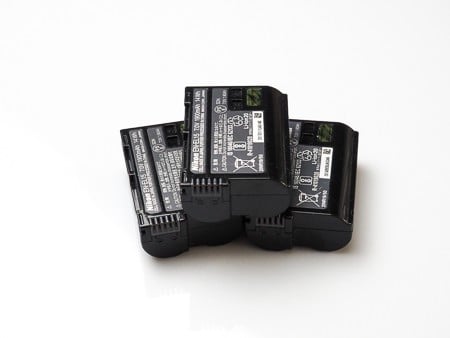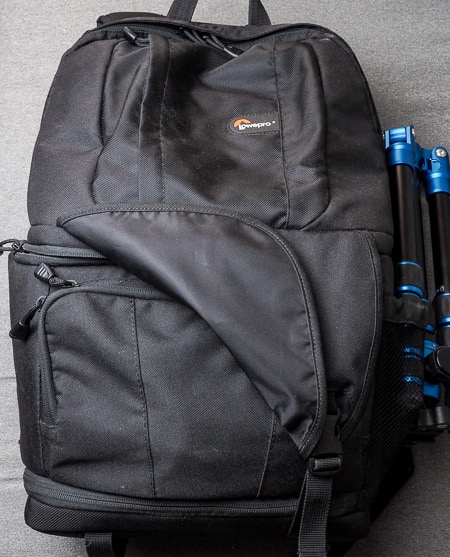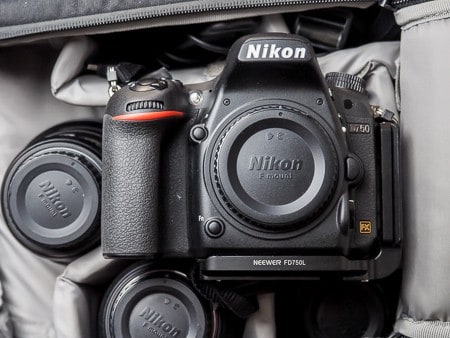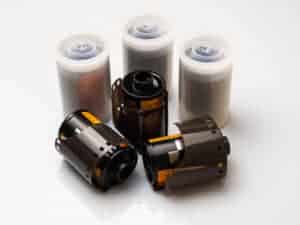Do You Have To Take Camera Out At Airport

With security screening procedures changing often, it's more than challenging than ever for photographers to fly with camera gear when going through TSA security with camera gear in your carry-on. Changing rules, unclear rules and TSA officer discretion are just a few things that add together to the confusion over what you can pack in your bear-on and what you tin't. Here are 9 tips for traveling through TSA security with camera gear. While these tips will help you go through security more easily, keep in mind that TSA officers can decide to do random searches of your bags and can make judgement calls over what tin can proceed in your carry-on onto the plane, and what tin can't.
ane. Photographic camera Batteries
 Batteries are the lifeblood of your photographic camera gear, and then it'south quite common to need to bring forth extra batteries when travelling. For smaller gear: cameras, flashes, etc. (I'll get to drones separately), the requirements for safely packing your batteries are the same, for the near function. The ane difference is with lithium batteries.
Batteries are the lifeblood of your photographic camera gear, and then it'south quite common to need to bring forth extra batteries when travelling. For smaller gear: cameras, flashes, etc. (I'll get to drones separately), the requirements for safely packing your batteries are the same, for the near function. The ane difference is with lithium batteries.
Lithium batteries are not allowed in checked bags then must exist part of your bear-on. They must also be protected from damage or brusk excursion when in your comport-on handbag. To do this, you'll need to have the batteries in their ain container or well secured in your bag. What I practise is keep my batteries in a separate, smaller pocket in my photographic camera bag, and I employ gaffer tape to secure the plastic terminal covers that originally came with the batteries onto them. If you lot don't have the terminal covers, you could apply gaffer tape to encompass the battery terminals.
ii. Drone Batteries
Drone batteries are considered large type consumer electronic batteries, which have special regulations governing them. Depending on the number of watt-hours the batteries are rated for, the regulations are different. There may exist limitations on how many batteries you can travel with, and too whether you lot demand permission from the airline to fly with them. For the most part, based on Jim's research, virtually drone batteries are okay. Check out Jim's video below for more information near these regulations, including how many you can fly with, and other data virtually flight with drone batteries.
3. Laptop
The recent changes to TSA rules country that electronics larger than a cellphone must be scanned through the 10-ray machine exterior of any pocketbook or carrying case, and in a plastic tray of its own. Laptops take been i of these electronics that take been separately scanned for years. When going through TSA security, you'll demand to make certain your laptop is readily accessible for individual scanning. Make certain that your laptop is easy to access or even in a laptop bag that is separate from your camera handbag, since near airlines allow one carry-on bag and one personal particular. Do not pack the laptop so tightly in a bag where yous will have to completely remove contents from your bag to go to information technology. Speaking of packing, that leads into my next tip.
iv. Carry-on bag
 Make certain your carry-on is packed in a neat and organized manner. If you lot're asked past the TSA officer to have carry-on contents in addition to your laptop or camera body inspected, a neatly organized handbag volition make things easier and quicker to unpack those items for inspection. As well, the improve organized and less "blimp" the handbag is, the easier information technology'll be for the TSA officers to view your deport-on contents on the ten-ray monitors. The easier information technology is for them to identify the contents, the less hazard you'll accept of additional scrutiny of your contents.
Make certain your carry-on is packed in a neat and organized manner. If you lot're asked past the TSA officer to have carry-on contents in addition to your laptop or camera body inspected, a neatly organized handbag volition make things easier and quicker to unpack those items for inspection. As well, the improve organized and less "blimp" the handbag is, the easier information technology'll be for the TSA officers to view your deport-on contents on the ten-ray monitors. The easier information technology is for them to identify the contents, the less hazard you'll accept of additional scrutiny of your contents.
5. Tripod
There's been a lot of debate about whether tripods with the ballhead fastened are allowed inside your carry-on bag, or fastened to the side of your bag. The short answer is yes information technology's allowed. I know of many photographers, Jim included, who have been able to get their tripod through TSA when fastened to the side of their bag. Correct now, the TSA prohibited items listing states that tripods are immune in bear-on bags but every bit with anything, it'south upward to the discretion of the private TSA officer. This is where a lot of the fence has come from.
Some TSA officers may decide non to allow tripods because it could exist used as a weapon or be considered unsafe, in particular if there are spikes mounted on the tripod legs. And then yes tripods are allowed equally carry-on, but the decision is still subject to the discretion of an officer. If you do take spikes, the best thing to do to ameliorate your chances of getting the tripod onto the plane in your bear-on bag would be to remove the spikes and pack them in your checked handbag. One of Jim's stories shows just how random their discretion tin can be…while Jim has been able to get his tripod on a plane dozens of times without issue, his son's plastic ninja star toy was taken. Go figure!
6. Take lens off camera
 When you pack your camera in your camera bag, make certain you remove the lens from the camera trunk, and apply the camera bodycap to comprehend and protect the photographic camera'south sensor and internal electronics. If the TSA decides to run the camera through the x-ray out of your camera purse, which it likely will given the new rules on electronics, at that place's still the chance of the camera sliding around and banging confronting the sides of that plastic tray. With a lens attached, if the lens housing has any significant forcefulness against it from being banged effectually, there's the chance of damage to the threads that the lens attaches to the camera body on. This tin can happen at other times too, when the camera is packed snugly in the padded sections of the camera bag, if the bag is dropped or knocked.
When you pack your camera in your camera bag, make certain you remove the lens from the camera trunk, and apply the camera bodycap to comprehend and protect the photographic camera'south sensor and internal electronics. If the TSA decides to run the camera through the x-ray out of your camera purse, which it likely will given the new rules on electronics, at that place's still the chance of the camera sliding around and banging confronting the sides of that plastic tray. With a lens attached, if the lens housing has any significant forcefulness against it from being banged effectually, there's the chance of damage to the threads that the lens attaches to the camera body on. This tin can happen at other times too, when the camera is packed snugly in the padded sections of the camera bag, if the bag is dropped or knocked.
While there'south still incertitude well-nigh what is considered an electronic item larger than a cellphone, some photographers have plant that it'southward only the photographic camera trunk that is subject to inspection. In view of this, keeping your lenses off your photographic camera will allow you to keep them safe during inspection inside your camera bag.What I would practice is place the photographic camera body in the scanning tray face up down (with the display screen facing up), to avoid whatsoever scratches to the display screen if the camera were to slide in the tray.
7. Picture show
For those of y'all who withal shoot moving picture, or have thought of shooting with film, you lot may already exist aware that undeveloped film is very sensitive to the x-ray machines. You'll need to take extra care of your moving-picture show when going through TSA screening, dissimilar digital cameras equally memory cards volition non be damaged past the x-ray  machines. Moving picture should not be packed in your checked numberless because the equipment used to scan checked bags can harm your film. You lot should keep your motion-picture show with you in your carry-on numberless. Even then, the x-ray machines at the TSA screening area can still damage your film so when packing film in your carry-on, here are a few things to keep in mind.
machines. Moving picture should not be packed in your checked numberless because the equipment used to scan checked bags can harm your film. You lot should keep your motion-picture show with you in your carry-on numberless. Even then, the x-ray machines at the TSA screening area can still damage your film so when packing film in your carry-on, here are a few things to keep in mind.
Lead lined film cases will help, but are not perfect. Some 10-ray machines have different intensity levels, and different pb cases have different thicknesses of pb. The manufacturer of the picture show cases will outline the parameters of how effective the cases will be. The ISO sensitivity of your movie also makes a departure. The more than lights sensitive, the more prone to damage the film is…ISO 100 film is less decumbent compared to ISO 1600 motion picture. Film loaded in your camera tin also be damaged, and so make sure your camera is empty of whatever film. You can also let the TSA officer know you lot take photographic camera film and request for information technology to exist paw searched instead of going through the x-ray machine.
8. Go on an eye on your camera gear
Going through the security checkpoint can be a location where you risk losing your camera gear, given that you are separated from your gear as information technology goes through the x-ray motorcar and y'all go through personal screening. Granted the risk is depression, only it is in that location since other travelers backside your or in front of you could grab your gear past mistake. Make certain you keep a shut eye on your gear as you lot become through screening. If you do happen to lose your gear while going through the TSA security checkpoint, yous should contact the TSA grouping at the airdrome in which you lost your gear. Speak with a TSA officer at the checkpoint or call TSA. To observe the right phone number, become to tsa.gov Spider web site and search for "lost and plant".
9. TSA Precheck or Global Entry
 If you are a frequent traveler, you lot tin can avoid a lot of the security inspection processes past signing up for TSA Precheck. It costs $85 for a 5 year membership, and will let yous go through security without needing to remove your shoes, laptops, liquids, belts and lite jackets. Of course, the TSA officers take the right to do random searches to everyone but for the most function, TSA Precheck tin can give y'all an expedited security screening procedure.
If you are a frequent traveler, you lot tin can avoid a lot of the security inspection processes past signing up for TSA Precheck. It costs $85 for a 5 year membership, and will let yous go through security without needing to remove your shoes, laptops, liquids, belts and lite jackets. Of course, the TSA officers take the right to do random searches to everyone but for the most function, TSA Precheck tin can give y'all an expedited security screening procedure.
To sign upwardly for TSA Precheck, all you need to do is submit an application online and schedule an in-person appointment at one of several hundred enrolment centers across the U.s.. The in-person appointment will include doing background checks and getting your fingerprints taken, besides every bit another optional checks you tin read more than nigh hither. One time canonical, you'll receive a Known Traveler Number which you lot tin include in your airline bookings. Your boarding laissez passer will have the TSA Precheck symbol printed on it, giving you access to the Precheck lanes at airports across the US.
Another option is Global Entry, which is a U.S. Customs and Edge Patrol program. Information technology includes TSA Precheck plus other expedited entry benefits. At select airports, you would only go to Global Entry kiosks, present your passport or U.S. permanent resident card, browse your fingerprints on the scanner and complete a customs declaration. The kiosk volition event you a transaction receipt and will direct yous to baggage claim and the leave. The application procedure is like to TSA Precheck, but costs $100 for a 5 year membership.
These are a few simple tips that volition help you get through TSA security more easily. Since the rules are constantly changing, it'south always a good thought to check the TSA website for the latest rules before yous pack. Do you have any other tips that take helped you when going through TSA? Share your experiences in the comments below!
Source: https://improvephotography.com/50721/9-tips-for-traveling-through-tsa-security-with-a-camera/
Posted by: pollardwhictibed.blogspot.com


0 Response to "Do You Have To Take Camera Out At Airport"
Post a Comment